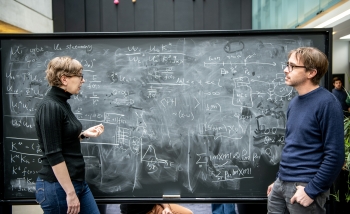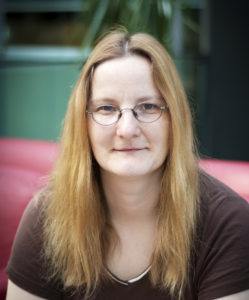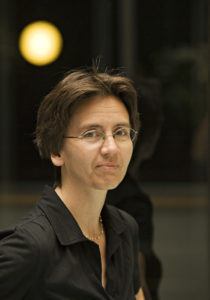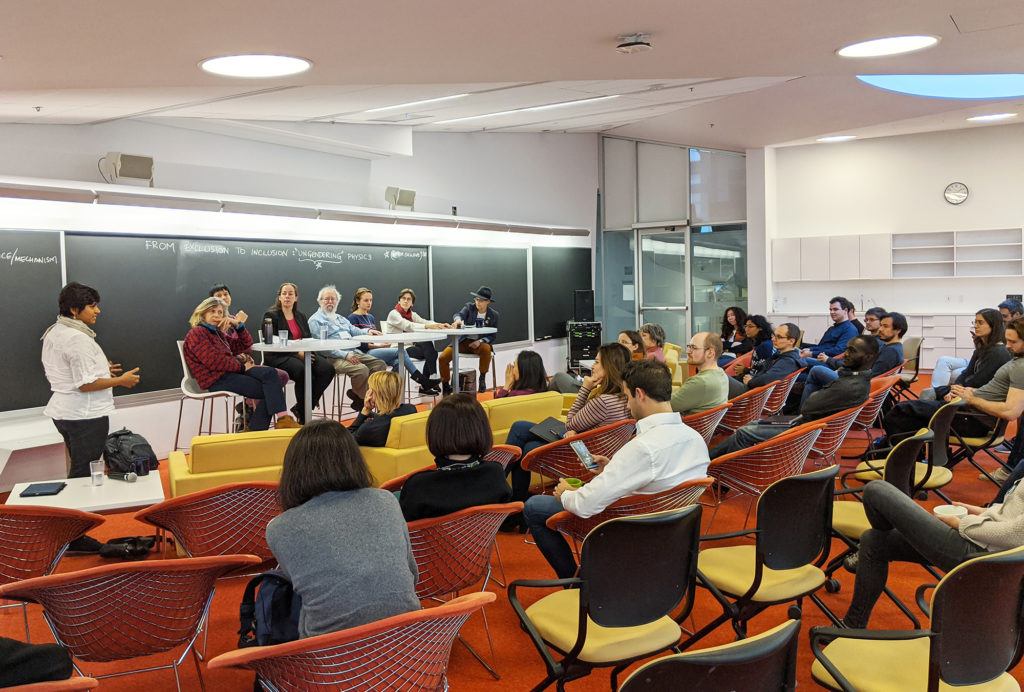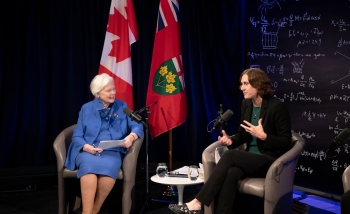When Astrid Eichhorn asked a question after a talk, heads did not turn.
That might not seem remarkable at first – after all, by all accounts, asking a question or making a remark after a scientific talk is a perfectly normal thing to do. But when you’re a woman in a male-dominated field, that simple act of speaking up is often enough to make you stand out.
At the “Emmy Noether Workshop: The Structure of Quantum Space Time,” however, Eichhorn was, for once, not in the minority. That’s because most of the participants – all experts in various aspects of quantum gravity – were also women.
The workshop, which took place at Perimeter Institute for five days in November 2019, brought together more than 40 researchers with a research interest in quantum gravity. Several participants were current or former members of the Simons Emmy Noether Program, which provides visiting fellowships for talented researchers to work at Perimeter at a critical stage of their careers.
For Eichhorn, an associate professor at the University of Southern Denmark and a visiting fellow at Perimeter, the lack of novelty regarding her presence was, itself, a novelty. “There isn’t this experience that everybody turns around like, ‘Whoa, where is this female voice coming from?’” Eichhorn said. “Here, it’s just normal to have female voices. That’s just a different type of atmosphere that I’m enjoying.”
Puzzling out the nature of spacetime
Bianca Dittrich, a Perimeter Faculty member and one of the workshop organizers, said they kept the workshop’s scientific theme deliberately broad to encourage discourse between the various approaches to quantum gravity that have sprung up in the past several decades.
“If you have very specialized workshops, people tend to also just communicate in very specialized language and don’t see the advantages which you only see if you have a bit of an outside view,” Dittrich said.
“Quantum gravity” encompasses efforts to bridge two landmark theories in physics: general relativity (which describes gravity, space, and time on large scales) and quantum mechanics (which describes phenomena at the smallest of scales).
The two theories have been at odds for nearly 100 years. At the heart of the disagreement is the nature of the fabric of the universe itself. In general relativity, spacetime is smooth and continuous; in quantum theory, at the level of subatomic particles, spacetime is discrete and granular, like pixels in a photograph.
The problem has been tackled from many different directions. Most of the researchers agree on one thing: no approach has gotten it quite right. At least, not yet.
Eichhorn suspects the map will emerge after all possible routes are laid over each other. “Right now, one of my focus points is to try to connect different approaches to quantum gravity, because ultimately I think we have produced some insights in these various approaches,” she said.
Connecting the dots along the route won’t be easy, though, she said. “It is difficult, because every single approach is also sort of technically involved and has its own language and jargon, so it’s just an investment of time and effort to understand one of them, let alone several. This is not something that happens at the snap of a finger.”
What’s more, not everyone agrees that progress can be made by picking the best parts of individual theories.
Renate Loll, a professor of theoretical physics at Radboud University, is one of the dissenters. “I don’t actually subscribe to that as a recipe for success. It sounds very plausible, ‘let’s just take the best of every approach,’ but that’s not how it works,” said Loll, who was also an invited speaker at the conference.
Still, Loll thinks there is benefit to crosstalk between the approaches. Similar pitfalls tend to crop up in every approach; getting together can help ensure each group isn’t reinventing the wheel.
Plus, the field is still wide open for progress. “I would say what makes it frustrating is also what makes it very exciting,” Loll said. “It’s not a theory we kind of know, and we only have to throw much more computational power at it to get the right numbers out – no, no. It’s that we are still trying to understand what the good questions are.”
Once the right questions are identified, Loll believes that the best chance of progress lies in pushing a specific approach to its breaking point. “One learns more from the in-depth rather than the in-breadth,” she explained.
Cultivating a culture of inclusion
Disagreements can be tricky to navigate, and clashes of scientific opinion are no exception. Workshop speaker Lisa Glaser said the talks throughout the week were a prime example on how to handle academic opposition well.
Glaser, a postdoctoral researcher at the University of Vienna, credits strong moderators with ensuring scientific disagreement doesn’t veer into personal aggression. “It’s nice to be at a conference with such a good discussion culture. The discussions are very vibrant, but also respectful,” she said.
Creating a space that is welcoming, inclusive, and equitable was a frequent subject of both formal and informal discussions throughout the week. The “Women in Physics” panel brought participants together to talk about the barriers that women and other minorities face within the field, along with potential solutions.
The panellists noted that, although many overt barriers have been dismantled, the ones that remain are subtler, both trickier to identify and to steer around. “The system, as it is now, deliberately selects against diversity, and we need to change that,” said Glaser.
Loll pointed out that women, more often than men, tend to have career trajectories that are more varied or meandering than the typical academic path. “Measuring people on a one-dimensional scale punishes people that don’t follow the standard trajectory,” she said.
Several panellists criticized the “genius syndrome” that permeates physics – the notion that great science is primarily done by brilliant individuals who often work alone. Placing an emphasis on genius undervalues collaboration, tenacity, and hard work. As workshop speaker Ruth Gregory from Durham University put it: “We recognize assists in sports. Why don’t we recognize them in science?”
Glaser pointed out that idolized geniuses are also less likely to be held accountable for any inappropriate behaviour, as the field fears losing their scientific contributions. In such situations, she asked, “Aren’t you holding back the field by eliminating all the other people who have been alienated by that person?”
Opening physics up to a broader diversity of people – on multiple axes, including gender, ethnographic, socioeconomic, and more – can drive scientific progress, said Eichhorn. “If you have sort of the same people, staring at the same problem, from the same point of view the whole time, you will probably not trigger too much progress,” she said. “When you have people coming in and looking at the problem from a completely new angle or with a new set of tools, then maybe you can create some progress.”
Glaser points out that the converse is also true: minority groups are often subject to an exhausting barrage of microaggressions, which, when added together, can leave a person feeling drained.
“We’re not science machines – we’re humans,” Glaser said. “Each of us has some aspect of themselves that is not just like every other. And all of these aspects, if we have to keep them at home, it makes us weaker. It costs us energy that we could be putting into science, and it makes our science worse. It makes science less vibrant, less appealing, less interesting.”
But bringing in underrepresented groups is only half the battle: the other half is making sure that everyone feels welcome and comfortable enough to stay. “It’s an effort that has to be done at every level,” Dittrich noted. “Otherwise, you have maybe very interested young women, but they will be frustrated at the higher-up steps.”
Ending on a note of optimism
The mix of topics was clearly well-received; by the end of the workshop, Dittrich had already received several requests to schedule a future one. “I do think it was very successful,” she said.
“This is not a women’s meeting – this is a meeting of quantum gravity, and it’s mostly women,” said Dorothea Bahns, a professor at the University of Göttingen.
“For me, that’s a great experience, because I think we’ve come a long way in 20 years. I think it’s important to make this point and to convey this to others, to young students especially.”
So, what’s the easier problem to solve: dismantling the centuries-old traditions that can work against an inclusive academic environment, or stitching together the fabric of spacetime?
That’s yet to be determined, but the workshop participants were optimistic that both are ultimately solvable.
Further exploration
About PI
Perimeter Institute is the world’s largest research hub devoted to theoretical physics. The independent Institute was founded in 1999 to foster breakthroughs in the fundamental understanding of our universe, from the smallest particles to the entire cosmos. Research at Perimeter is motivated by the understanding that fundamental science advances human knowledge and catalyzes innovation, and that today’s theoretical physics is tomorrow’s technology. Located in the Region of Waterloo, the not-for-profit Institute is a unique public-private endeavour, including the Governments of Ontario and Canada, that enables cutting-edge research, trains the next generation of scientific pioneers, and shares the power of physics through award-winning educational outreach and public engagement.
You might be interested in

What is it like to be part of an underrepresented gender identity in physics?
February 9, 2024
